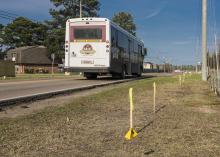Information Possibly Outdated
The information presented on this page was originally released on June 11, 2015. It may not be outdated, but please search our site for more current information. If you plan to quote or reference this information in a publication, please check with the Extension specialist or author before proceeding.
'Smart Growth' principles can help small Miss. towns
Small, rural towns often face the challenge of providing a quality-of-life standard needed to attract new residents, while some communities on the fringe of large cities may struggle to meet the infrastructure demands that come with population spillover.
The Mississippi State University Extension Service recently published “Smart Growth for Small Towns,” an online resource that details 10 principles of Smart Growth and how local leaders and citizens can use them to help meet these development challenges. Smart Growth is a sustainable urban development program introduced by the American Planning Association in 1997.
Michael Seymour, an Extension associate professor of landscape architecture, joined Jeremy Murdock, a research associate in the MSU Stennis Institute of Government and Community Development, in producing the online guide as an educational tool for officials and citizens engaged in community development.
Seymour said much of the information about Smart Growth is geared toward urban areas, and the objective of creating the development guidelines for the Extension website was to have an easily accessible set of recommendations more applicable to rural communities.
“Smart Growth principles can be confusing if you don’t understand the larger purpose behind them, and we wanted to try to make the purpose of the principles clear,” Seymour said. “Also, we both travel a lot -- both around the state and throughout the South -- and wanted to promote some of the great small town success stories.”
In addition to a desire to inform people about the tradeoffs involved in planning decisions, Seymour said his interest in the project stemmed from his research on the history and evolution of town squares in Mississippi using historic photos and maps from state archives.
“I find the way that small towns have evolved to be fascinating but wanted to contribute something that would be tangible and hopefully useful to people in Mississippi,” he said. “We usually think of Smart Growth as an urban issue, but our small towns can benefit from some of the ideas as well. Overall, we were trying to use our experiences to help us create the site.”
Murdock, who has served on the Starkville Planning and Zoning Commission and taught urban planning courses for Extension, said his goals in the project were to keep summaries of the 10 Smart Growth principles brief and avoid technical planning terms and language.
“Much of the Smart Growth material is written for planners, designers, landscape architects and other planning professionals,” Murdock said. “Most rural communities do not have planning professionals on staff, so the elected officials and community leaders are often not familiar with the concepts and terminology often used in those materials. We wanted these to be very visual and clear to the average citizen.”
The online overview uses illustrations and photographs, many of which Murdock took, to explain and show examples of towns that have embraced Smart Growth concepts.
“Most of the photographs used throughout the documents are from small towns, many from Mississippi, which also demonstrates how these principles are already in place in similar size communities,” Murdock said. “We wanted to show that these principles are based on historic patterns of development that many cities, even small towns, followed before World War II and are not only applicable to large cities.”
The principles can be beneficial to small towns because they are based on examinations of older U.S. cities that attempted to document the elements of a successful city, Murdock said. More than 90 percent of Mississippi’s 289 municipalities fall into the category of small, rural towns.
“The good news is that most small towns have not experienced a lot of growth during their history, which means that they have not made the costly mistakes that larger cities have,” he said. “Larger cities across the country are struggling to correct decades of inefficient growth and are suffering, especially financially. Small communities are able to learn from their mistakes and do it right the first time.”
Small towns can also make costly mistakes without the insight of planning expertise, he added.
“In my experience working with small towns in Mississippi, many of them are so desperate for any type of development that they often accept very poor growth that is actually doing more harm than good,” Murdock said. “They are sacrificing long-term financial obligations for a short-term boost in sales tax revenue. Smart Growth principles can help community leaders understand how to grow their cities in the most efficient way based on sound planning principles.”
Get more information from the Smart Growth for Small Towns page and http://sig.msstate.edu/smartgrowth.
Contact: Michael Seymour, 662-325-3012; or Jeremy Murdock, 662-325-1658








